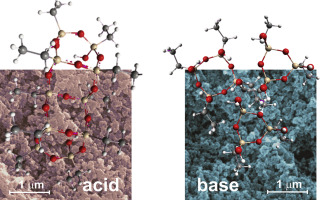Polymer ( IF 4.1 ) Pub Date : 2018-03-09 , DOI: 10.1016/j.polymer.2018.03.013 Agnieszka Kierys , Piotr Borowski , Radosław Zaleski , Mariusz Barczak

|
This paper presents novel types of polysilsesquioxane (PSQ)–polymer composites formed through polycondensation of ethyltriethoxysilane in the spatially limited system of polymer pores in the presence of acid or base catalysts vapors. In addition, it gives an insight into the architecture of the PSQ network. It is shown that PSQ formed under acidic conditions is mainly composed of long ladder-like structures, whereas small three and four-membered rings are dominating structural units in the base set PSQ. Theoretical calculations extend the common interpretation of the 29Si NMR spectra according to which signals at ca. −47, −55, and −65 ppm can be simply attributed to T1, T2, and T3 Si atoms, respectively. Moreover, they indicate that T1 and T0 29Si NMR signals should be easily distinguishable from T2, and T3 (and among each other), since T0 is placed upfield (−31.5 ppm) as compared to the other mentioned 29Si signals.
中文翻译:

气相法在空间受限的交联聚合物孔体系中通过气相法形成聚倍半硅氧烷网络
本文介绍了新型的聚倍半硅氧烷(PSQ)-聚合物复合材料,它是在酸或碱催化剂蒸气存在的条件下,通过在空间受限的聚合物孔中将乙基三乙氧基硅烷缩聚而形成的。此外,它还可以深入了解PSQ网络的体系结构。结果表明,在酸性条件下形成的PSQ主要由长梯状结构组成,而小的三元和四元环是基集PSQ中的主要结构单元。理论计算扩展了29 Si NMR光谱的一般解释,根据该解释,信号在ca处发生变化。-47,-55和-65 ppm可以简单地归因于T 1,T 2和T 3硅原子。此外,它们表明T 1和T 0 29 Si NMR信号应易于与T 2和T 3(以及彼此之间)区分开,因为与其他提到的29相比,T 0处于高场(-31.5 ppm)硅信号。











































 京公网安备 11010802027423号
京公网安备 11010802027423号